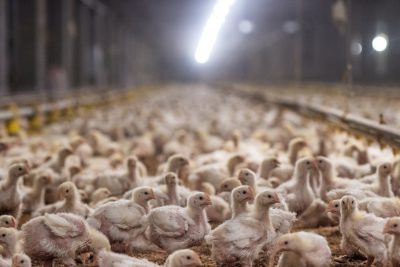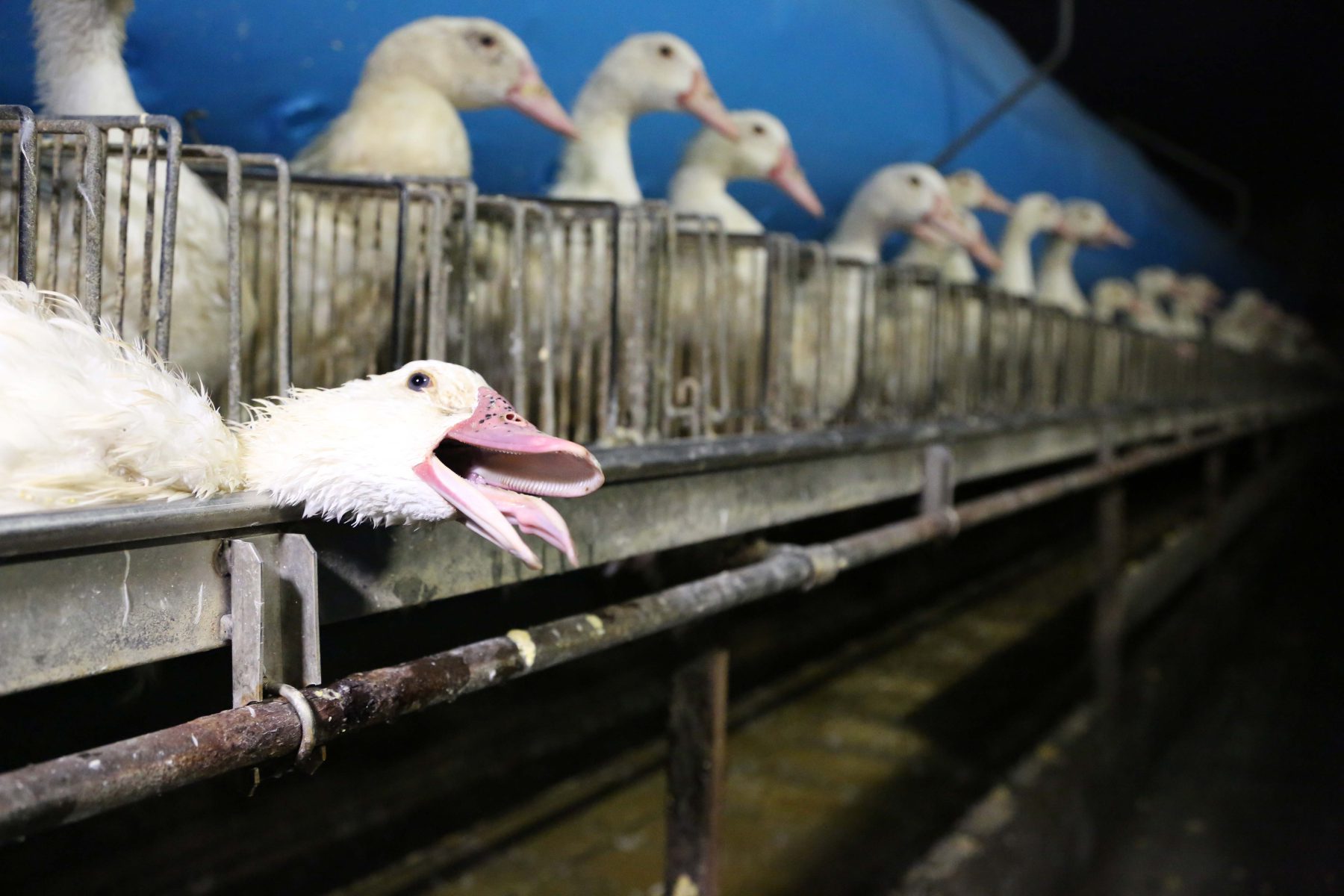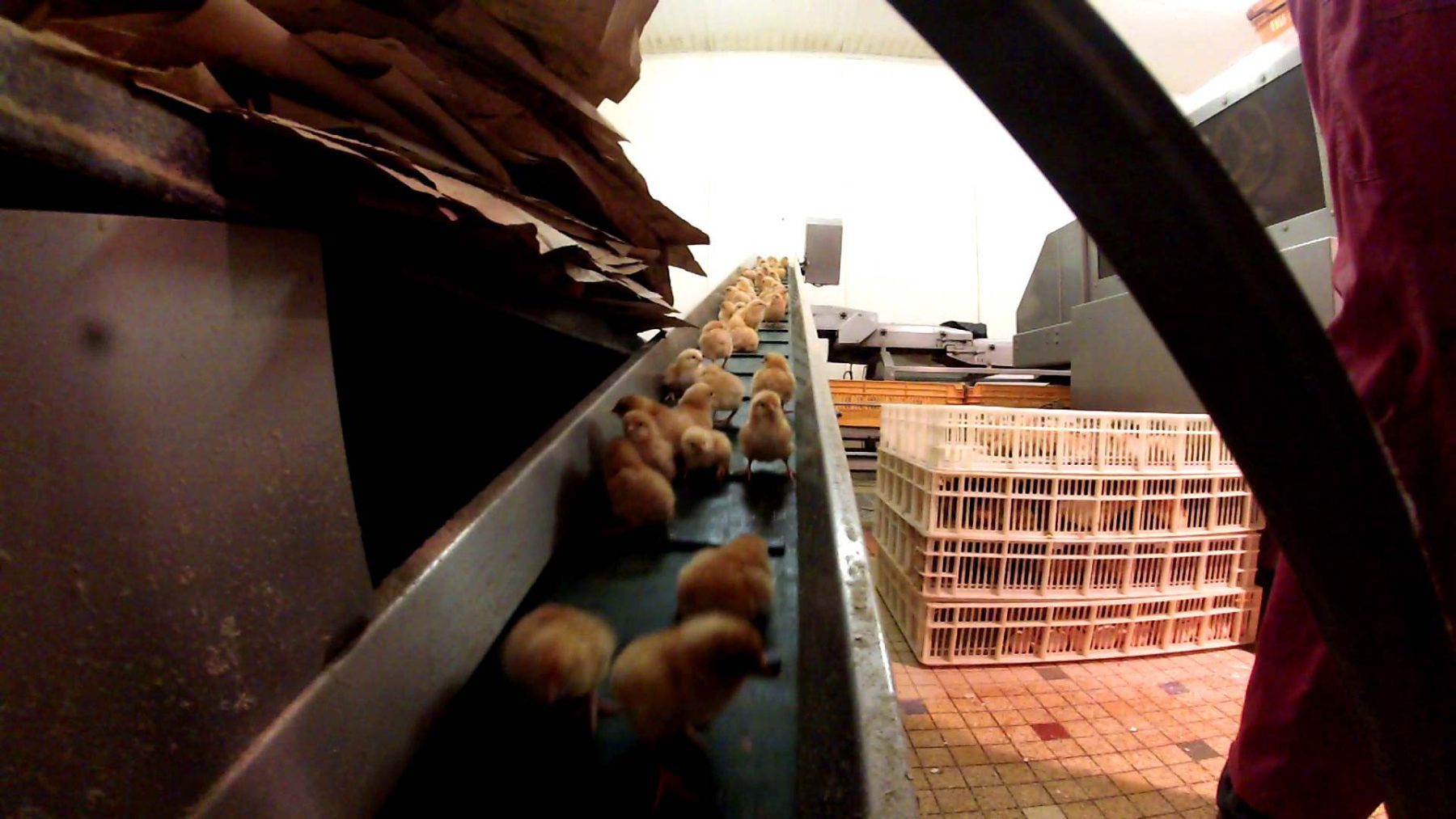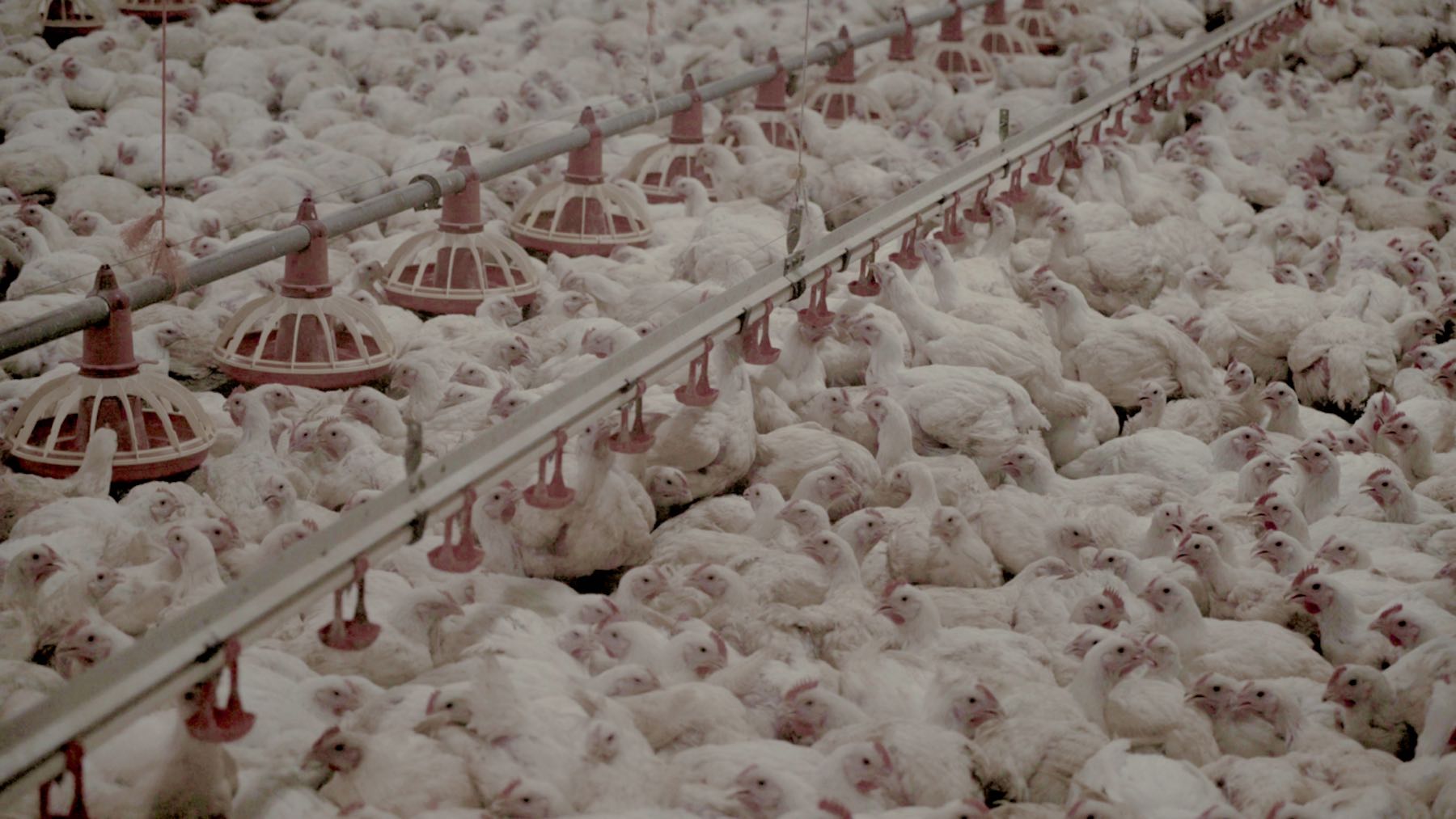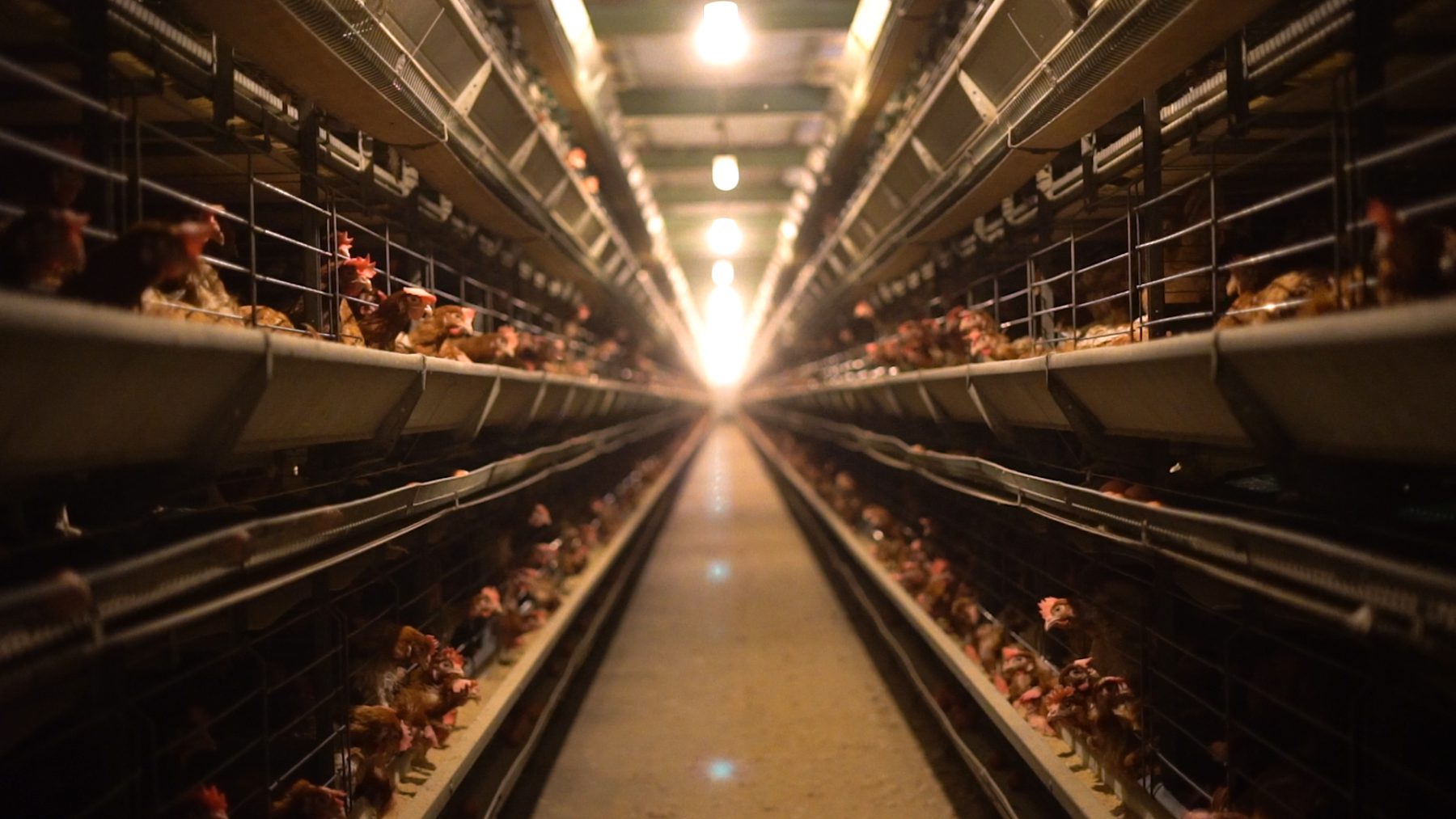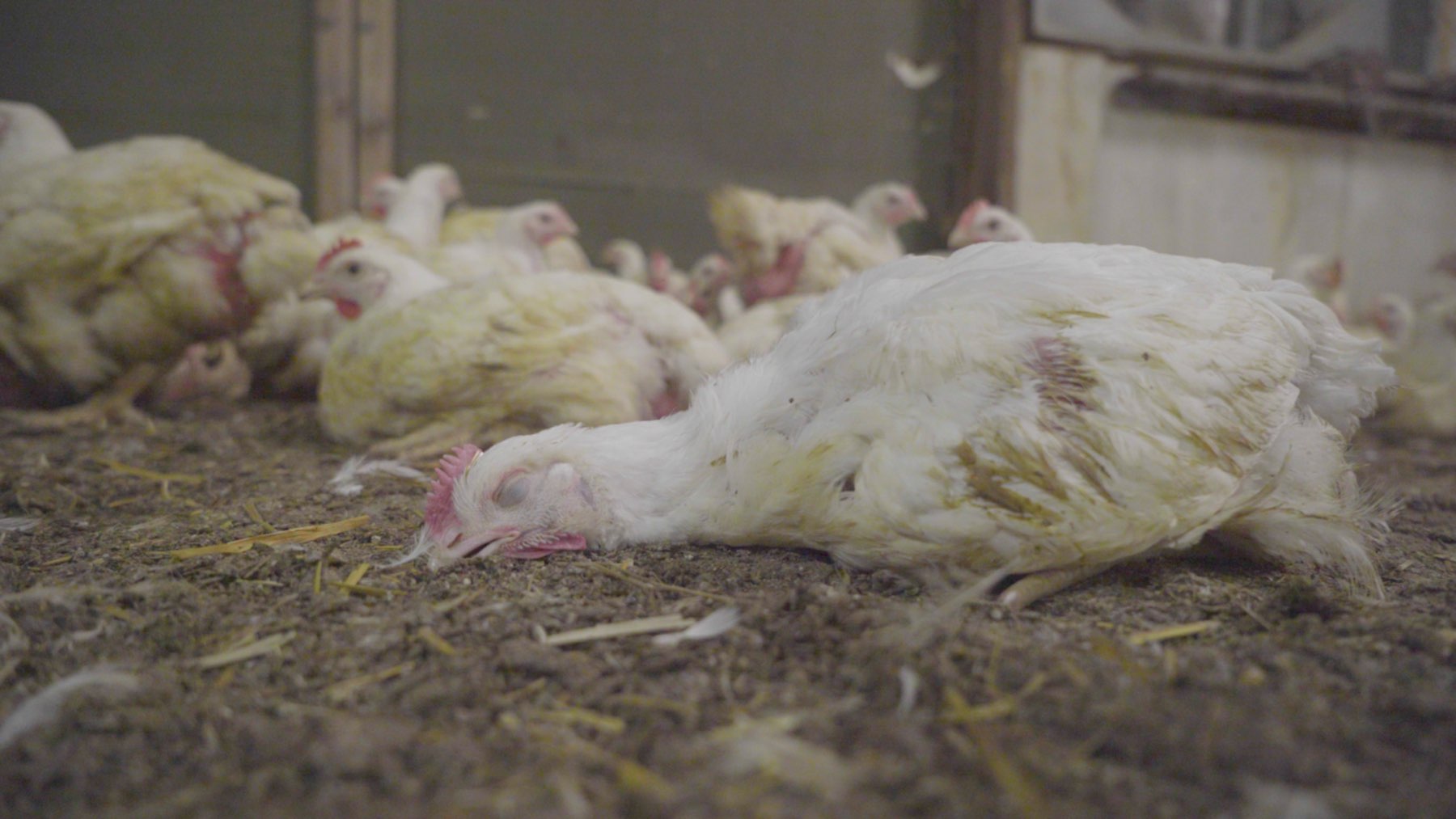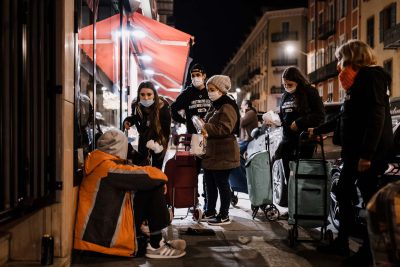The consumption of chicken, turkey and other poultry meats continues to rise. Inevitably, this means an increase in the number and size of farms, the number of birds suffering, and the negative impacts on global health and the environment. So, what exactly does poultry farming mean for birds, people and our planet?
What Is Poultry Farming?
Poultry are types of birds who have been bred from wild species and are now considered ‘domesticated’. Really, this just means they have been bred, exploited and killed for thousands of years. Poultry are farmed intensively in vast numbers for their meat, eggs and feathers.
What Are The Four Types of Poultry?
There are actually many types of poultry, including peacocks, ostriches and emus but the most commonly farmed are chickens, ducks and geese, guinea fowl and turkeys. These species are among the most abused animals on the planet.
Chickens
Astronomical numbers of chickens are farmed globally for their meat, with most being held inside immense warehouses, each holding tens of thousands of birds. Nothing about the process is natural, not even the birds’ bodies which have been purpose-bred to grow so fast that broken bones and heart failure are commonplace. Their feed is unnatural, and often contains soy from deforested lands. Lighting is manipulated to ensure they keep eating and putting on weight. By the age of six or seven weeks, despite still being chicks, their bodies have ballooned, and they are sent to slaughter.
Still more chickens are farmed for their eggs. This is a different breed to those farmed for meat, because egg farmers don’t want these birds to gain weight – that would be an unnecessary expense. They want them to lay lots of eggs while consuming the bare minimum feed, which is why these poor birds look so emaciated.
Battery cages are still commonly used for hens farmed for their eggs. Did you notice the word hen instead of chicken here? That’s because only female chickens lay eggs. All the economically worthless male chicks who are hatched into this industry are gassed, crushed or macerated on their very first day of life. Billions of birds are killed every single year by the egg industry.
Ducks And Geese
These are water fowl, and should be living on lakes and rivers but most of those eaten spend their lives inside factory farms. These are the same crowded, miserable warehouses that chickens are kept in. Life here is devoid of anything worthwhile. Water birds need to dabble, swim and dive but are not even afforded a bucket of water to dip their heads into. Without it, not only are their most important natural behaviors denied them, but they suffer physical ailments. Ducks need to be able to dip their heads into water to rinse their eyes and without it they can go blind. Their beaks and nostrils also become dirty and blocked and, unable to clean them naturally, they can be seen shaking their heads to try and to remove the obstructions that impact their breathing.
For these birds, used to swimming and diving in cool waters, the crowded factory farm environment is not only miserable, it causes heat stress, but there is nowhere for them to go where they can cool down.
Ducks and geese are not used to standing all day. As a result, they may suffer painfully crippled legs. Geese farmed for foie gras – the translation of which is fatty liver – are force-fed large amounts of grain to ensure their livers become enlarged and diseased. Force-feeding involves a tube being pushed into the stomachs of birds and a large quantity of feed pumped in. Injuries, infections and death are common, but for every bird who endures this, the pain and stress is indescribable.
Turkeys
It’s a similar story of suffering and abuse for turkeys. Factory-farmed birds are denied fresh air, the ability to roam and graze, to nest, rest and form friendships. These inquisitive creatures have nowhere to go and nothing to do. They have been deliberately bred to have large breasts – because that’s where the favored meat is – and this has left them clumsy and ungainly, and even unable to breed naturally. On farms, turkey ‘milkers’ are employed to extract the semen from the males and insert it into the females. That’s how unnatural turkey farming is.
Like other farmed birds, the enormous weight gain demanded of them puts a stress on their legs and hearts. Lameness, broken bones and heart attacks are regular occurrences inside those factory farm sheds.
Turkeys are also slaughtered at a very young age, typically between just 12 and 20 weeks old, with their unnaturally large bodies often becoming the centerpiece of human celebrations of peace, thankfulness and kindness.
Guinea Fowl And Squabs
Guinea fowl and pigeons are farmed less often than other poultry species in many parts of the world, but where they are farmed, the system of exploitation is just as ruthless as for chickens, turkeys, ducks and geese. These species are becoming increasingly popular across Africa. Guinea fowl are hardier than some species, and as many farmers have no access to veterinary care, they are the ones most likely to survive the few weeks allotted to them.
It’s not just guinea fowl in Africa that fail to get veterinary care, however. Given the vast numbers of birds in every shed on every poultry farm around the world, individual care is impossible. That’s why the death rate inside those sheds is so high. Vets are simply not called out to a sick bird, and so millions suffer to death right there in the sheds.
Different Poultry Sectors
There are several different aspects to poultry production, and although we may think specifically of farms when we think about these birds, the industry has other lesser known – but just as shocking – facets, too.
Meat Production (Broilers Breeding)
All those birds inside all those warehouses have to come from somewhere. Specific breeds of birds are kept as breeders and are artificially inseminated to create all those lives that end up being killed. These mother hens – who are such fantastic carers that we refer to conscientious human parents by this phrase – never even get to sit on their eggs, let alone rear their young. Their job is to lay large numbers of fertilized eggs that will immediately be taken away from them. Their lives literally depend on it. When production declines, they too are sent to slaughter.
Egg Production (Layers Breeding)
The same is true in the egg industry. Naturally, mother and chick would communicate with one another even before the young hatch, but when it comes to the mass exploitation of animals, nothing is left to nature. The birds kept to lay fertilized eggs will never meet their young, and they are all killed – like the chicks they never got to meet – when of no further commercial use.
Poultry Feed Production
To feed the billions of animals crammed into factory farms, feed is traded around the world. One key component of chicken feed is soy, and this is often grown on deforested land, including in the Amazon. Another component is fish. Dragging tonnes of fish from their natural environment so they can be processed and fed to factory farmed birds is a double whammy of unnecessary cruelty and a double whammy of environmental degradation.
Chicken Breeding (Hatchery)
All the fertilized eggs from the broiler breeders and layer breeders are sent to industrial hatcheries. There are no nests here, no mothers keeping the eggs warm and reassuring their young with chirrups and coos. At the hatchery, eggs are hatched in giant incubators, then the chicks are immediately sexed. The egg industry does not want males as they cannot lay eggs, and so all male chicks are killed as soon as they have hatched – they may be crushed, macerated or gassed to death. Increasingly, birds farmed for meat are also sexed and segregated, as single-sex flocks are often found to be more productive. The surviving chicks are boxed up and transported to the factory farm where their short, miserable lives begin.
Egg And Meat Processing
Then comes the process of turning a live animal into a slab of meat. At the slaughterhouse, birds are hung upside down by their legs while fully conscious (imagine how that feels with broken bones). They may be stunned by being dragged through an electrified water bath and then their throats are cut. Increasingly, birds are gassed to death inside purpose-built chambers but neither method can be said to be pain-free or humane.
Once dead, the birds are bled, their feathers loosened in a scalding rank, and then their bodies are systematically taken apart.
How Are Poultry Treated On Poultry Farms?
Farmed birds are treated as disposable commodities. It seems there is no limit on how much suffering we are prepared to inflict on chickens, turkeys and other birds, so long as it doesn’t dint the profits.
Antibiotics
Because of the appalling treatment of these birds, many become sick. To try and reduce economic losses, farmers give large quantities of antibiotics to the birds. This not only helps fend off infections but it makes the birds grow faster, and that has proved quite an incentive to the overuse of these drugs. But this reckless waste comes at a hefty price. It has helped fuel antibiotic-resistant bugs, which kill people. Already each year in the U.S., at least 2.8 million people get an antibiotic-resistant infection, and more than 35,000 people die, and yet widespread antibiotic use on farms continues.
Arsenic
Why on Earth would farmers add arsenic to poultry feed? After all, this chemical is highly toxic to people, with long-term exposure being linked to cancer of the skin, bladder and lungs. Despite this, in the United States and elsewhere arsenic is added to the feed of farmed birds to promote growth, kill parasites that cause diarrhea, and make the colour of chicken meat more attractive. Incredibly, an estimated 70 per cent of the chickens farmed in the U.S. are still fed arsenic.
Battery Cage
The vast majority of hens farmed for their eggs in the United States are held inside battery cages. These cramped, barren cages do not allow birds to stretch their wings, roost or nest. The wire mesh harms their feet, causing painful lesions, while the strain of being so overcrowded causes severe stress among the birds. In countries where battery cages are banned, ‘enriched’ cages – slightly larger cages, with a bit of wood for a perch and a plastic curtain – are still permitted, and the suffering continues.
De-beaked
In an attempt to reduce the understandable aggression caused by being caged, the ends of the birds’ beaks are cut off, adding injury to injury. This procedure can cause both short-term and chronic pain. Where the blade slices too high, there can be nerve damage and birds left unable to eat will simply starve to death.
Indoor Broilers
Almost every bird reared for their meat in the U.S. (and elsewhere) is factory farmed, and the only time they will leave the shed is the day they are being transported to slaughter. Naturally inquisitive birds, chickens like to explore their surroundings, scratch in the earth, dustbathe, roam, nest and roost. Industrial farms make none of this possible. Those who say they are happy to eat meat because animals ‘had a good life and a pain-free death’ cannot know what factory farming and slaughter actually mean for the individuals who are forced to endure them.
Transport
On the last day of the birds’ lives, the catching gangs arrive. Their aim is to empty each shed of its tens of thousands of birds as quickly as possible. They grab birds by their legs and wings (again, these may be broken already or become broken in the process). In the rush, some birds may be grabbed by the necks. They are slammed into crates and loaded onto trucks in all weathers – from blistering cold to searing heat – and are transported over long distances, for many hours. There is no rest, no food or water. Just hour upon hour, crammed inside a crate, frightened.
How Poultry Are Killed
There are two systems of slaughter, one is throat-cutting, which many birds endure while fully conscious, and the other is gassing. Inside the gas chambers, birds gasp as they frantically try to take in oxygen. It’s clear that, whatever the method, the process is not gentle or compassionate. It is also clear that the birds do not want to die.
Health Impacts
You might think that there must be a good reason to cause this much suffering, perhaps that poultry meat provides us with the safest and best source of vital nutrients. But this is not so. Every nutrient we need can be found on a plant-based diet, while poultry meat comes with an array of added dangers.
Avian Influenza
The virus that causes avian influenza is harmless in aquatic birds, where it originated. But when it has the chance to mutate and spread inside domesticated birds – which it can do very easily inside those crammed, squalid factory farm conditions – it can cause serious disease in people. One type – H5N1 – has a 60 per cent mortality rate when it infects people. One pandemic expert warned: “Factory farms pack tens of thousands of immunocompromised animals in confinement systems where viral diseases are commonplace. The huge numbers of animals and their ill health multiply the risk of viral mutation. Poultry farms are ticking time bombs.”
E. Coli
E. coli bacteria normally live in the intestines of both human and non-human animals, and most are harmless. However, some types cause illness, and can be passed from infected birds to people who eat their flesh. In 2018, research conducted at George Washington University found E.coli in fresh poultry products that could cause bladder infections and other serious conditions in people. The type identified in this study – E. coli ST131 – is known to travel from the bladder to the blood and it claims thousands of lives each year in the United States.
Salmonella
In crowded farms and at the slaughterhouse, where terrified birds defecate in fear, Salmonella spreads easily. The evisceration process – where the dead birds’ organs are scraped out – can also spread the bacteria from one carcass to another. When it gets into people – from eating the carcass or the eggs of infected birds – the symptoms can be serious, even fatal. Twenty percent of global poultry products are contaminated with Salmonella and in the United States, Salmonella causes about 1.35 million illnesses, 26,500 hospitalizations, and 420 deaths every year.
Campylobacter
Poultry can carry Campylobacter without showing any sign of illness. The bacteria are carried in their intestines, livers and other organs and can contaminate the flesh during the slaughter process. Contaminated poultry meat is the most common source of Campylobacter infection in the United States.
Symptoms include diarrhea, fever, stomach cramps, nausea and vomiting, and there are more serious complications such as irritable bowel syndrome, temporary paralysis, and arthritis. In people with weakened immune systems, Campylobacter occasionally spreads to the bloodstream and causes a life-threatening infection.
Environmental Impacts
One serious environmental impact of poultry farming is the pollution of soil and water with nutrients, pathogens and heavy metals. An excess of nutrients being deposited in the waters can lead to eutrophication and the depletion of oxygen which destroys aquatic life, and creates ocean dead zones.
Another key issue is the feed. Importing grain and soy from deforested lands on the other side of the world is a serious consequence of factory farming poultry, while emptying the oceans of fish to feed factory farmed birds is contributing to the devastation of marine life.
In terms of greenhouse gas emissions, poultry production is more damaging than almost all fruits, vegetables, grains, legumes and nuts, including soymilk, tomatoes and rice. For this reason, Oxford University researchers say that going vegan is the single biggest thing we can do to reduce our climate impact.
Worker Health And Safety
A system as rotten as factory farming is bad news for workers, as well as consumers, the environment and birds. The chemicals given to birds to keep parasites and illness at bay can cause skin and lung problems in workers, while the dust and ammonia from the litter inside the sheds is linked to respiratory diseases such as asthma.
Of most concern, however, may be the diseases that can pass from birds to people. Farm workers are on the front line, and can become infected with a whole range of bacteria, viruses and other pathogens. When the deadly H5N1 erupts, it is farm workers who are most likely to succumb.
Poultry Statistics
- The number of chickens worldwide has more than doubled just since 1990. In 2018, there were 23.7 billion chickens in the world.
- Iowa has the highest number of chickens of any U.S. state with 72.58 million birds. Indiana and Ohio are next, with around 44 million and 43 million birds respectively.
- The U.S. is the world’s largest poultry meat producer, with 18 percent of global output, followed by China, Brazil and the Russian Federation.
- Despite the risks to both individual and global health, and the suffering caused to animals, the consumption of poultry meat continues to rise.
What Can You Do To Help
The only way to end the intensive farming of birds is to stop eating them and their eggs. To end their suffering, reduce the risk of global pandemics, and ease the burden on our planet, we should choose plant-based foods instead. This does not mean going without the taste and texture of meat if that is what you like! There are plenty of plant-based chicken, turkey and other poultry products that look, cook and taste like meat, from holiday roasts to deli slices. Make the switch, and you can help create a kinder and healthier world.
